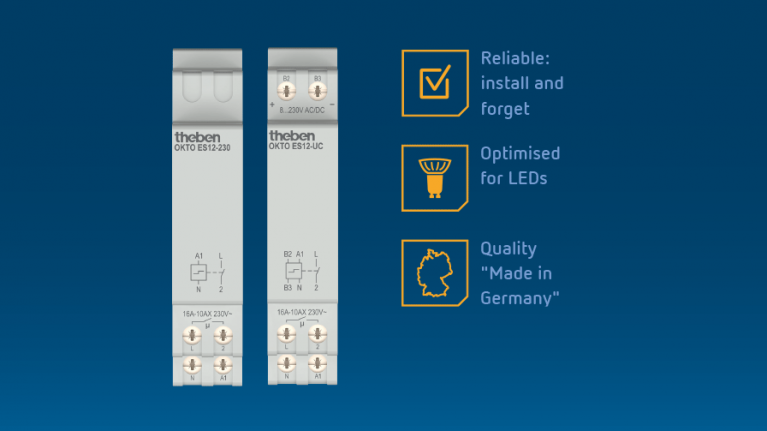So what is an impulse switch or impulse relay?
Impulse switches such as the Theben OKTO are electromechanical or electronic devices that provide simple and energy-saving lighting control. Impulse switches are used when multiple switching points in an electrical installation are used to switch the same load. Typical applications of impulse switches and impulse relays include hallways and corridors in private homes and public buildings, corridors and landings in houses and hotels, and corridors in company buildings. In these cases, all entrances are usually equipped with buttons. With these, lights can be switched on and off from all points.


How does an impulse switch or impulse relay work?
With an impulse switch such as the Theben OKTO, electrical current can be switched on or off from any distance. The switching status of the switch changes by means of an electrical impulse. This switches the unit back to the previous position and holds it mechanically until the next control pulse. As a result, the same loads can be controlled via a single impulse relay with several buttons.
Impulse relays provide a simple, easy-to-install and cost-effective alternative to off, double-throw and intermediate switches.Impulse switches are usually simpler and less expensive to wire. The wiring is similar to that of a staircase light timer switch. The current for the load flows through a single potential-free switching contact and not through all the light switches. This considerably reduces fault susceptibility. If a button fails, the load can be switched using the remaining buttons.
For example, you may want to be able to switch the light on and off at several points in a long corridor. This can be done using a cross circuit with several double-throw and intermediate switches. However, this would require complex wiring with four wires per intermediate switch. In contrast, impulse switches such as the Theben OKTO simplify installation considerably. Only two wires are required for each button. What's more, existing circuits can be quickly and easily expanded with additional buttons.
Are there any differences between an impulse switch and an impulse relay?
No. An electromechanical or electronic impulse switch such as the Theben OKTO is often also referred to as an impulse relay, impulse switch or stepping switch. Despite their different names, there is no difference in their application and how they work.
What types of impulse switches are there?
Impulse switches such as the Theben OKTO are available in electromechanical and electronic versions. The devices are mounted on a top-hat rail (DIN rail, mounting rail). They are designed for a maximum switching current of 16A.
How quiet are electronic impulse switches?
| Electronic impulse relays like the Theben OKTO ES operate very quietly, in fact they are almost silent. They are also suitable for use in public buildings and hotels as well as in private homes. Electromechanical impulse switches like the Theben OKTO S produce an audible clicking sound when a button is pressed. They are therefore suitable for use in less noise-sensitive environments such as corridors and hallways in commercial buildings. |
Which buttons can be used with impulse switches?
| Impulse relays can only be used with buttons (retractive) and not with switches. In principle, all types of buttons can be connected. The load capacity of the contacts must be designed for the control voltage of the installed impulse switches (230V AC or 8V to 230V for universal impulse relays). |
Electronic impulse switches and LED
|
Electronic Theben OKTO ES impulse relays enable high switching loads of up to 600W. This makes them ideal for use with LED lamps. The following example highlights what is important in this context: in the corridors of a large building, incandescent light bulbs are replaced by LED retrofit lamps. Suddenly, the installed impulse relays fail. The cause is found to be burnt or welded contacts. The devices were overloaded even though the nominal power of the electrical installation was significantly reduced. Inrush currents are the problem here. Conventional incandescent light bulbs cause inrush currents of ten times the nominal current. LED lamps with capacitive characteristics, on the other hand, generate inrush current pulses in the μs range. These can be 1,000 times the nominal current or more. In the VDE authorised Theben test laboratory, a inrush current of 19A was measured on one occasion with a 1.8W LED lamp. That is 1,706 times the nominal current! Impulse relays designed for C-loads cope better with extreme inrush currents. Theben OKTO ES impulse switches offer a zero-cross switching. It calculates the zero-crossing of the alternating voltage sine curve. At this moment, the inrush current is at its minimum during switching. This protects the relay contact and extends its service life at high switching loads. Bottom line: impulse switches are a practical solution for switching loads on and off via multiple buttons. For example, they are ideal for controlling lighting efficiently in hallways and corridors. Electromechanical impulse relays such as the Theben OKTO S are a simple and robust solution that does not consume standby power. Electronic impulse relays such as the Theben OKTO ES are ideal for use with LED lamps owing to their high switching loads of up to 600 W. |
Technical data Theben OKTO:
| OKTO ES12-230 | OKTO ES12-UC | OKTO S12-230 | OKTO S22-23 | |
| Item no. | 3120130 | 3120131 | 3120120 | 3120122 |
| Type | Electronic | Electronic | Electromechanical | Electromechanical |
| Number of contacts as NO contacts | 1 | 1 | 1 | 2 |
| Operating voltage | 230 V AC | von 8 V bis 230 V | 230 V AC | 230 V AC |
| Supply voltage/Frequency of control voltage 1 | 230 V/ 50-60 Hz | 230 V/ 50-60 Hz | 230 V/ 50 Hz | 230 V/ 50 Hz |
| Max. switching current (cos φ = 1) | 16 A | 16 A | 16 A | 16 A |
| Max. incandescent lamp load | 2600 W | 2600 W | 1800 W | 1800 W |
| Max. fluorescent lamp load | 2600 VA | 2600 VA | 700 VA | 700 VA |
| Zero-cross switching | ✓ | ✓ | - | - |
| LED switching load (> 2 W) | 600 W | 600 W | 200 W | 200 (400) W |
| Glow lamp current | 100 mA | 100 mA | 3 mA | 3 mA |
| Manual operation possible | - | - | ✓ | ✓ |
| Potential-free/Safety extra-low voltage (SELV) | - | ✓ | ✓ | ✓ |
| All-pin deactivation N and L | - | - | - | ✓ |
| Stand-by consumption | 0,3 W | 0,3 W | 0,0 W | 0,0 W |

